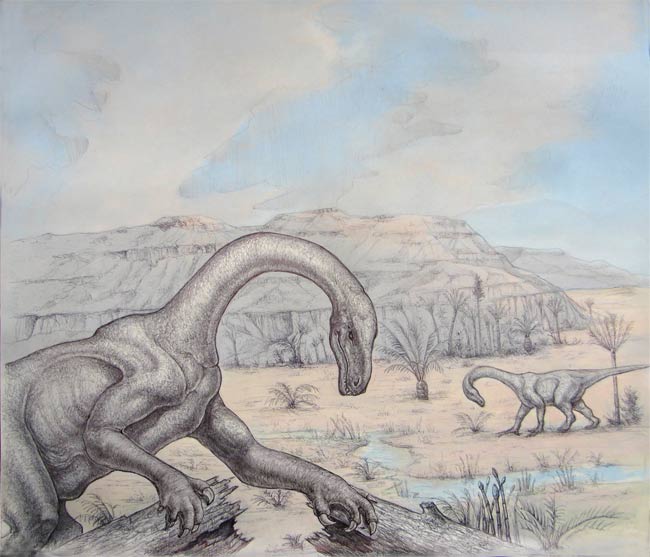Most Dinosaurs More Like Barney Than T. Rex

Dinosaurs might not have been the mighty conquerors that everyone thinks they were.
Instead of overwhelming the world with force, dinosaurs might have instead moved in when no one was looking.
Conventional wisdom suggests that soon after dinosaurs originated in what is now South America, they rapidly invaded every corner of the world, defeating their rivals by virtue of strength to rule for about 160 million years.
Now, however, a new species of dinosaur suggests that instead of overpowering weaker species, dinosaurs came into dominance by taking advantage of a catastrophe that wiped out the competition.
"We used to think of dinosaurs as fierce creatures that out-competed everyone else," said researcher Timothy Rowe, a vertebrate paleontologist at the University of Texas at Austin. "Now we're starting to see that's not really the case."
The new dinosaur, named Sarahsaurus, was a 14-foot-long, 250-pound (4.2 meters, 113 kilograms) sauropodomorph, a relatively small ancestor of sauropods, the largest animals to ever walk the Earth. The dinosaur lived about 190 million years ago in a setting much like today's Nile Valley, with lush vegetation on either side of a river and barren desert just beyond.
Rowe and his colleagues discovered the creature in Arizona in 1997. Excavating it proved hard, as the site was in the high desert and prone to windstorms. Since the researchers could not reach the site by car, they had to spend days lugging chunks of the rock-encased fossil back to camp.
Sign up for the Live Science daily newsletter now
Get the world’s most fascinating discoveries delivered straight to your inbox.
"It was a rigorous challenge, the kind I love," Rowe told LiveScience.
Ten million years before Sarahsaurus lived, one of the five greatest mass extinctions in Earth's history, the Triassic-Jurassic event, wiped out many potential competitors of dinosaurs. The researchers now reveal that Sarahsaurus and two other early sauropodomorphs migrated to North America in separate waves long after that extinction. At the same time, none migrated there before the extinction.
"They were humbler, more opportunistic creatures," Rowe added of dinosaurs. "They didn't invade the neighborhood. They waited for the residents to leave and when no one was watching, they moved in."
"It's the story of a recovery after a great extinction," Rowe said. "That's what makes it poignant for me — it's a portent of our future. We're undergoing an immense extinction right now, and by examining the fossil record, we could get a good predictor of our future."
Rowe was also intrigued by the new dinosaur's hands.
"Its hand is smaller than my hand, but if you line the base of the thumbs up, this small hand is much more powerfully built than my hand and it has these big claws," he said. "It's a very strange animal. It's doing something with its hands that involved great strength and power."
"They may have been digging up roots or ripping apart rotten logs looking for small creatures," Rowe explained. "These animals are often thought of as herbivores, but I'm not so sure of that."
Sarahsaurus also had physical traits usually associated with gigantic animals. For example, its thigh bones were long and straight like pillars, yet were not much larger than a human's thigh bones.
"Some of the features we thought were tied to gigantism might instead be linked with the forceful way of life," Rowe said. "You could imagine they fastened onto things with their front and rear legs and arched their backs to tear things apart."
The researchers plan on scanning the fossils in greater detail to learn more about how the dinosaurs behaved.
They detailed their findings online Oct. 6 in the journal Proceedings of the Royal Society B.










